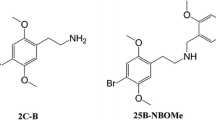Abstract
The structures of the hydrochloride hydrates of pentylone and dibutylone and the hydrochloride salt of ephylone, three new clandestinely-manufactured designer cathinones are described. Pentylone is (±)-1-(1,3-benzodioxol-5-yl)-2-(methylamino)pentan-1-one, dibutylone is (±)-1-(1,3-benzodioxol-5-yl)-2-(dimethylamino)butan-1-one, and ephylone is (±)-1-(1,3-benzodioxol-5-yl)-2-(ethylamino)pentan-1-one. These three drugs have recently appeared in law enforcement seizures of illicit drug materials and are referred to as NPS (new psychoactive substances). The free base pentylone crystallizes as the hydrochloride monohydrate salt with H bonds extending from the protonated amine to the Cl− anion very close to a center of symmetry, thence to a water of hydration, resulting in an interesting six-sided species of approximately chair conformation whose components are linked by hydrogen bonds. An interesting feature of the dibutylone free base is that it crystallizes as the HCl sesquihydrate salt. Most of the street drugs crystallize as their hydrates; but, unlike most of them, dibutylone HCl. 1.5H2O crystallizes as a kryptoracemate in space group P212121. A kryptoracemic crystal is one whose asymmetric unit contains a racemic pair, but still belongs in a Sohncke space group. The phenomenon was recognized relatively recently and, to date, there are very few drugs identified as crystallizing thus (for more on this topic, see below). In this structure, both independent amine cations have a chloride counter-anion, and they share three water molecules of crystallization, with the chloride anions and the waters forming an interesting H-bonded cyclic array. The free base ephylone crystallizes as the HCl salt and is a brand new substance, not appearing until about November 2015. The packing of all three of these cathinones contains “sandwich” π-π stacking interactions where the phenyl rings of the cations are stacked face-to-face with each other, with distances ranging from 3.531 to 3.862 Å. These compounds are among the most recent examples of cathinone-based stimulants designed to circumvent existing drug laws, and they represent a new danger to recreational drug users.







Similar content being viewed by others
References
Kalix P (1981) Psychopharmacology 74:269–270
Valente MJ, Guedes de Pinho P, Bastos ML, Carvalho F, Carvalho M (2014) Arch Toxicol 88:15–45
Stogner JM, Khey DN, Agnich LE, Miller BL (2016) Am J Crim Just 41:97–111
Palamar JJ, Salomone A, Vincenti M, Cleland CM (2016) Drug Alcohol Depend 161:200–205
Marinetti LJ, Antonides HM (2013) J Anal Toxicol 37:135–146
United Nations Office on Drugs and Crime (UNDOC) (2013) The Challenge of New Psychoactive Substances. http://www.unodc.org [accessed July, 2016]
Brandt SD, Freeman S, Sumnall HR, Measham F, Cole J (2011) Drug Test Analysis 3:569–575
Zuba D, Byrska B (2013) Drug Test Analysis 5:420–429
Westphal F, Junge T, Girreser U, Greibl W, Doering C (2012) Forensic Sci Int 217:157–167
United States Drug Enforcement Administration (DEA) (2016) Emerging Threat Report First Quarter 2016, Law Enforcement Communication [Not publicly available]
European Monitoring Centre for Drugs and Drug Addiciton (EMCDDA) (2016) European Drug Report 2016: Trends and Developments. http://www.emcdda.europa.eu/publications/edr/trends-developments/2016 [accessed July, 2016]
Paillet-Loiller M, Cesbron A, Le Boisselier R, Bourgine J, Debruyne D (2014) Substance Abuse and Rehabilitation 5:37–52
Córdova-Sintjago T, Villa N, Fang L, Booth RG (2014) Mol Phys 112:398–407
Simmler LD, Rickli A, Hoener MC, Liechti ME (2014) Neuropharmacology 79:152–160
Russell MJ, Bogun B (2011) Forensic Sci Int 210:174–181
Bruker (2009) SAINT, Version 7.23a. Bruker AXS Inc., Madison
Bruker (2009) APEX 2, Version 2.0–2. Bruker AXS Inc., Madison
Bruker (2009) SADABS. Bruker AXS Inc., Madison
Sheldrick GM (2015) Acta Cryst C71:3–8
Sheldrick GM (2015) SHELXT. Acta Cryst A71:3–8
Sheldrick GM (2008) SHELXTL. Acta Cryst A64:112–122
Flack HD (1983) Acta Cryst A39:876–881
Hunter CA, Sanders JKM (1990) J Am Chem Soc 112(14):5525–5534
Wheeler SE, Houk KN (2008) J Am Chem Soc 130(33):10854–10855
Koeppe H, Ludwig G, Zeile K (1969) Boehringer Ingelheim GmbH. US Patent No. 3478050
Zaitsu K, Katagi M, Kamata HT, Miki A, Tsuchihashi H (2008) Forensic Toxicology 26:45–51
Glennon R (2014) Adv Pharmacol 69:581–620
Bernal I, Cai J, Myrczek J (1995) Acta Chem Hungarica 132:451–474 In memoriam Mária Ács
Bernal I (1995) American Crystallographic Association Annual Meeting, 23–28 July 1995, Montreal, Quebec, Canada. Abstract 4a.1.e
Bernal I, Watkins SF (2015) Acta Cryst C71:216–221
Fábián L, Brock CP (2010) Acta Cryst B66:94–103
Bernal I (1992) J Chem Educ 69:468–469
Bernal I, Lalancette RA (2015) Comptes Rend Chimie 18:929–934
CSD = Cambridge Crystallographic Structural Database CCSD, Cambridge Crystallographic Data Centre, 12 Union Road, Cambridge CB2 1EZ, UK, release 1.18. They can be contacted at http://www.ccdc.cam.ac.uk
Acknowledgement
The authors would like to acknowledge support by National Science Foundation NSF-CRIF Grant No. 0443538 for part of the purchase of the X-ray diffractometer.
Author information
Authors and Affiliations
Corresponding author
Ethics declarations
Conflict of interest
The authors declare that they have no conflict of interest.
Additional information
This paper is dedicated to Professor Lou Massa on the occasion of his Festschrift: A Path through Quantum Crystallography
Rights and permissions
About this article
Cite this article
Wood, M.R., Bernal, I. & Lalancette, R.A. The hydrochloride hydrates of pentylone and dibutylone and the hydrochloride salt of ephylone: the structures of three novel designer cathinones. Struct Chem 28, 1369–1376 (2017). https://doi.org/10.1007/s11224-017-0951-x
Received:
Accepted:
Published:
Issue Date:
DOI: https://doi.org/10.1007/s11224-017-0951-x




